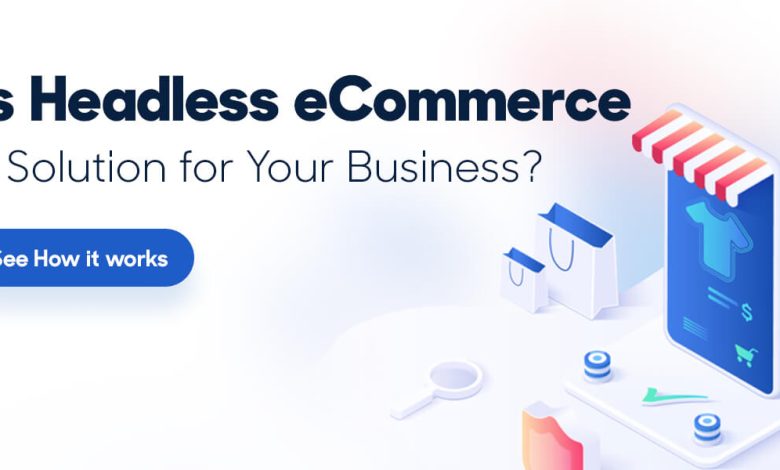Is Headless The Right Solution For Your Business?

Headless is the decoupling of a website’s front-end presentation layer from its back-end site functions. Developers can integrate a company system on the backend to handle all company functionality while still delivering high-quality content experiences using their preferred front-end technology.
Headless enhanced companies’ platforms offer PCI compliance, fraud control, security, and inventory management with connections to more significant, important infrastructure points like ERPs, OMSs, PIMs, and POS. It’s simple to understand how headless may give brands more company platform options from the headless commerce definition above. A content-led or experience-led approach, such as headless, is frequently the obvious choice for experience-focused firms, such as direct-to-consumer (DTC) brands and those that largely rely on influencer and native advertising.
Advantages Of Headless Commerce
For eCommerce to be successful, it needs a headless architecture which makes it a fantastic plan for your company, especially if you’re thinking about adding new digital channels. Let’s review some of the main advantages you can anticipate if you become headless.
Business Relevance
Going into headless eCommerce can provide your business with an advantage over rivals and allow it to stay relevant when new channels and devices are introduced.
Better user experience
Customers may buy products from you by utilizing your website, their smartwatch, or a voice assistant.
Omnichannel selling
You can design unique user experiences and distribute your items and content across a variety of sales channels.
Faster Content Delivery
Headless eCommerce allows the front end to swiftly and efficiently retrieve data from the back end without affecting performance.
Flexibility
In a headless system like eCommerce, your development team can use any preferred programming language or technology and modify it independently without causing harm.
Rapid Updates
Any system component can be updated more quickly without compromising the entire system’s functionality or modifying it in any way.
Speed To Market
After creating a headless eCommerce system, you may duplicate it and improve it for global SEO.
More Secure Delivery Of Material
Headless systems use application programming interfaces (APIs), which are frequently more secure, to deliver content. At any time, you can swiftly roll out security upgrades.
Lower Cost
Headless allows you to attract organic traffic with dynamic, seamless customer experiences rather than just sponsored advertisements, which lowers conversion rates and customer acquisition costs.
Greater Platform Control
Headless eCommerce enables you to preserve the front-end solution that works for you while enhancing or upgrading the parts of your backend that don’t.
Disadvantages Of Headless E-commerce
We’ve discussed how headless eCommerce can improve customer shopping and help you expand your business. Let’s now examine the disadvantages of employing headless eCommerce.
High Cost
A front-end presentation layer must be created from scratch to have a headless eCommerce platform. It also implies that more costs will be incurred for creating a new theme and user interface, as well as for including other system connectors.
Order management systems, Enterprise resource planning (ERP), and other third-party interfaces, such as those that connect to your eCommerce platform, are all priced separately.
The cost of maintaining and updating the front-end system will be in addition to the initial setup fee. A dedicated developer can also be required if you want to create a headless CMS and handle various tech stacks.
Extreme Complexity
You can experiment with a bespoke front-end using a headless eCommerce system by adding new functionality and payment methods across various sites. However, its creation and upkeep are complicated. Because of this, not every organization can benefit from implementing a headless system.
To test your APIs when deploying the headless architecture, you would need a sizable development team. Keep in mind that to guarantee the system is error-free, front-end and back-end engineers must work closely together.
If you have a small team and limited resources, you can also hire a third-party provider to assist you in managing your headless platform.
Lots Of Work
You will work with numerous vendors and different teams to manage your content and distribute it through many channels while employing a headless eCommerce. It implies that your platform will need a lot of upkeep, especially if you integrate two platforms.
For instance, you would need to maintain two systems if your eCommerce service was Magento and WordPress was headless. You will need more staff to regularly monitor the many components, such as the checkout process, payment security, and web speed performance on eCommerce sites.
Your headless storefront may not be properly optimized if you don’t have a sufficient and capable crew to construct a headless eCommerce solution. You must be aware of the team’s capabilities when managing multiple tech stacks.
What Distinguishes Traditional eCommerce From Headless eCommerce?
Between headless eCommerce and traditional eCommerce, there are some game-changers:
- Headless e-commerce platforms typically offer greater scalability and flexibility than conventional e-commerce platforms. They separate the front-end and back-end of the platform, enabling autonomous development and deployment of each.
- Compared to conventional e-commerce platforms, headless e-commerce solutions generally offer a better user experience (UX). They are well-liked because they give developers the ability to make unique front-ends that may be optimized for any device or screen size.
- Compared to conventional e-commerce platforms, headless e-commerce platforms are frequently more expensive. It is because creating a unique front-end requires more development effort.
- Compared to conventional e-commerce platforms, headless e-commerce platforms typically take less time to market. It’s possible to create and deploy the frontend and backend independently.
- Compared to managing conventional e-commerce platforms, managing headless platforms can be more difficult. It is a result of the front-end and back-end teams’ improved coordination.
- Unlike traditional e-commerce, which relies on specialized hardware, headless e-commerce communicates with the back end using APIs. It makes headless e-commerce more adaptable by making it simple to interface with outside apps.
- Headless e-commerce is usually easier to use on mobile than traditional e-commerce because it can build the front-end for mobile devices.
- Compared to traditional e-commerce, headless e-commerce can be more difficult to set up and maintain because it requires more technical knowledge.
Conclusion
The answer to this query above relies on the particular requirements of your company. The above solution might not be the ideal choice if your company platform needs a lot of customization or if you need to combine it with other company systems.
On the other hand, if you require a scalable and adaptable company platform that is simple to interface with other systems, the solutions may be suitable for your company.






